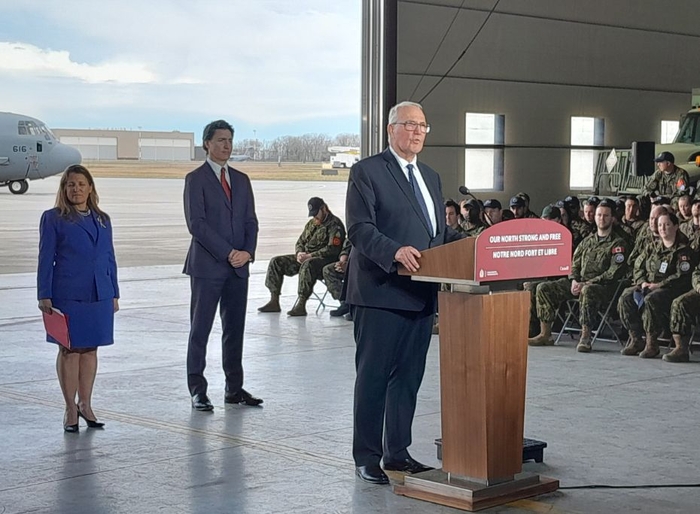Our North, Strong and Free: Canada’s Defence Policy Update Promises More Money
BY JAMES CARELESS
Show me the money: On April 8, 2024 — the day of the total solar eclipse — the Department of National Defence (DND) did just that as it released its much-anticipated Defence Policy Update (DPU). Entitled ‘Our North, Strong and Free: A Renewed Vision for Canada’s Defence’ — a nod to DND’s 2017 ‘Strong, Secure, Engaged’ policy that it updates — the DPU promises additional DND funding to the tune of $8.1 billion over the next five years and $73 billion over the next 20 years.
“Our North Strong and Free invests in new surveillance capabilities for land, sea, and air in the north,” said Prime Minister Justin Trudeau during the DPU’s unveiling at CFB Trenton (Ontario). “It leverages Canada's world class technology, including in AI Quantum, so we can stay ahead of the curve. It creates jobs and importantly, it supports all those of you who serve.”
“The investments, which will be in Budget 2024, will bring our defence spending to 1.76% of GDP by 2029- 2030,” said DND Minister Bill Blair. “This is a very significant and necessary step towards reaching our NATO commitment of 2% of GDP and by 2030 our government will have almost tripled our defence budget from 2014-2015.”
“Consistent with this commitment, Our North, Strong and Free also puts Canada on track to exceed NATO’s target of 20% for major equipment expenditures as a proportion of defence funding, and lays the foundation for future growth in the Canadian Armed Forces, including through a more regular cycle of review,” said the Our North, Strong and Free document. .jpg)
CANADIAN SOVEREIGNTY – A TOP PRIORITY
“The top priority of the Canadian Armed Forces is the defence of Canada and Canadians,” stated Our North, Strong and Free in its ‘Our Vision for Defence’ section. The choice of the word ‘North’ in its title is no accident: “We must place particular focus on defending the Arctic and North and its approaches against new and accelerating threats through credible deterrence.” Russia expansionism is the key threat in this arena, but DND sees China as a possible threat as well.
“To better protect our Arctic and northern regions from emerging and existing threats — such as advanced submarines, hypersonic and cruise missiles, surveillance activities — and to enhance our ability to respond to emergencies and disasters, we will establish greater presence, reach, mobility and responsiveness across Canada, including our Arctic, through a network of northern operational support hubs, a fleet of airborne early warning aircraft, deployable sensors on our coasts and underwater, a satellite ground station in the High Arctic, enhanced foreign intelligence capabilities, and new tactical helicopters,” Our North, Strong and Free said.
Priority Number Two is “deterring and defeating threats to the continent that we share with the United States, our closest ally,” Our North, Strong and Free said next, citing Canada’s 2022 commitment of $38.6 billion over 20 years to help modernise NORAD as proof of its sincerity.
Priority Number Three (based in the order used in this document) is protecting global security: “We will continue playing an important role confronting Russian aggression through a steadfast commitment to NATO assurance and deterrence measures ... Together with the United States, we will defend NATO’s western flank, and with our NATO allies we will defend NATO’s northern regions.” Our North, Strong and Free also said that Canada will continue to play a role in the Indo-Pacific, Middle East, the Americas, and Africa.
Worth noting: “Going forward, Canada will publish a National Security Strategy every four years,” the DPU said. “We will move away from undertaking significant policy reviews on an episodic and unpredictable basis, and move towards a more systematic approach that allows us to regularly assess the security environment and its implications for Canada, take stock of progress against our plans, and address the gaps in an integrated manner, leveraging the full range of national security tools at the government’s disposal.”
WHAT THE DPU MEANS TO CANADA’S DEFENCE INDUSTRY
Our North, Strong and Free is important to the Canadian defence industry for what it said about DND’s actions going forward.
Take Canada’s unwieldy and time-consuming defence procurement process, which the defence industry wants to see fixed. “Public Services and Procurement Canada, National Defence, Innovation, Science and Industry, and the Treasury Board Secretariat have launched a review of our defence procurement system,” said the DPU. “This includes examining internal processes used by Defence to define requirements and approve projects, and looking at the broader set of rules, regulations and policies that govern military procurement. This effort will clarify mechanisms to facilitate the timely delivery of military equipment, enable increased use of government-to-government arrangements where it makes sense to develop strategic partnerships, and look at how best to leverage existing programs to strategically invest in the domestic capacity needed by the military.”
“Defence procurement takes too long in Canada and needs to be faster and more effective,” the DPU observed. “We will think differently about how we procure equipment, how to better maintain and upgrade it over time, and how to ensure it is optimized to meet the diverse needs of our members. We will also compress the timeline of major acquisitions, to reduce the operational and financial risks of delays and gaps between capabilities being retired and new ones being added.”
“Procurement has always been a challenge because there are two sometimes competing pressures on procurement,” said the Prime Minister. “We obviously want to get the best possible equipment for our Canadian Armed Forces at the best possible price to taxpayers, but we also want to build up our own production capacities in Canada to make sure there are good jobs for Canadians.” Meanwhile, the federal government is willing to aid the private sector when it comes to ramping up production to meet pressing military needs — such as replacement ammunition for the Canadian Armed Forces — but not to the extent of putting the Canadian economy on a ‘war footing’.
“Limited government support can bridge the gap to ensure that domestic capacity is available when we need it most,” said Our North, Strong and Free. “To support Canadian industry to meet the ammunition demands of Canada and our closest allies, Canada will seek to accelerate the establishment of new artillery ammunition production capacity in Canada, creating skilled jobs for Canadian workers for the long term and generating economic benefits for Canadian communities. It will increase the Canadian Armed Forces’ resilience by establishing a reliable Canadian supply of NATO-standard ammunition at a time of unprecedented need and limited global production capacity. To capitalize on our industrial investments, the Canadian Armed Forces will establish a greater strategic reserve of battle-decisive munitions.”
“Ramping up our production is vital because, in fact, production is deterrence,” Blair said, “and it supports thousands of good jobs right across this country to our industry partners.”
On a larger scale, Our North, Strong and Free promises to “change Defence’s approach to working with industry, innovators, and researchers — moving away from transactional approaches for acquiring capabilities to sustained strategic partnerships founded on transparency and trust. This means more regular engagement and, through regular four-year reviews, greater transparency and certainty about our plans for future investments. Through long-term partnerships, Defence can pursue an expanded set of goals in defence procurement, including the rapid onboarding of new technologies, and deeper integration with allied supply chains and innovation networks, securing a reliable supply from Canadian industry.”
“Building up Canada’s defence capabilities must also include building up our defence industrial base,” the DPU added. “They will also fill critical gaps in functions that are essential to carrying out our operations today and into the future, such as staffing, security screening, and information technology.”
Other items that matter to the Canadian defence industry: “To accelerate the integration of new technologies into our vehicles, vessels, aircraft and other equipment, Defence will pilot a Continuous Capability Sustainment approach to upgrading equipment,” said Our North, Strong and Free. “While the traditional approach is to wait years to do minor upgrades to major equipment to align them with major mid-life overhauls, a continuous approach will give Defence the flexibility to rapidly integrate the latest technology and innovations in more regular, incremental maintenance cycles. We will ensure a reliable supply of defence materiel, free from disruption or interference through a Defence Supply Chain Resilience Strategy.”
As well, the federal government “will participate in the newly established NATO Innovation Fund, which will offer additional funding streams for innovative Canadian entrepreneurs,” the DPU promised. “The Fund is the world’s first defence-focused multi-sovereign venture capital fund, providing investment in start-up firms developing dual-use, emerging and disruptive technologies critical to our defence. These include artificial intelligence, big-data processing, quantum-enabled technologies, autonomy, biotechnology and human enhancement, novel materials, energy, propulsion, and space capability.”
NOT THE LAST WORD
All this being said, the DPU is not intended to cover all future possible procurements. “For example, we talk about exploring and defining the submarine capabilities we're going to need to patrol and protect our Arctic in the coming decades,” said Prime Minister Trudeau. “Those are investments that Canada is going to be making in our Canadian Armed Forces, but we haven't yet defined exactly what types of submarines and how they're going to be deployed. So we haven't put in the money that Canada will be spending on submarines in the coming years into this calculation.”
As for when Canada will actually meet its 2% GDP NATO funding level? Prime Minister Trudeau wouldn’t commit to a date. This being said, “We will want to increase the size of the Canadian Armed Forces to meet the challenges of the world we're meeting and that is going to require more investments.” he observed. “So even as we project getting up to 1.76% of GDP ... we know there is more to come over the coming years as Canada continues to step up in a more uncertain and quite frankly more dangerous world.”
James Careless is CDR’s Ottawa Bureau Chief







